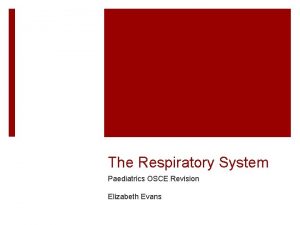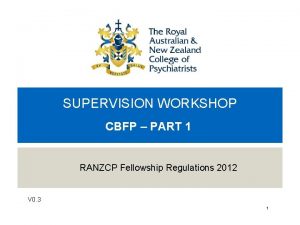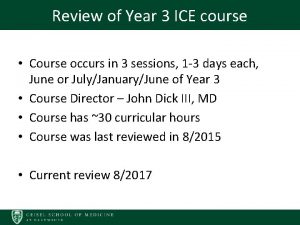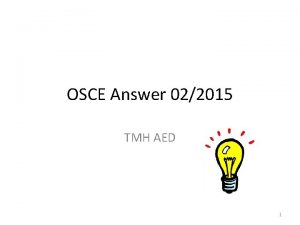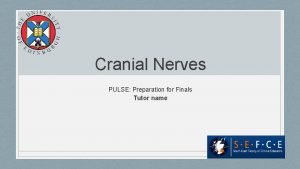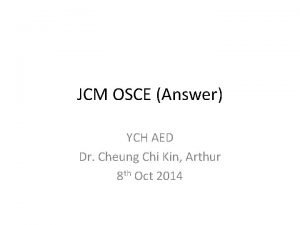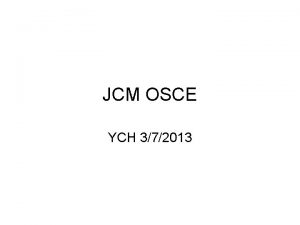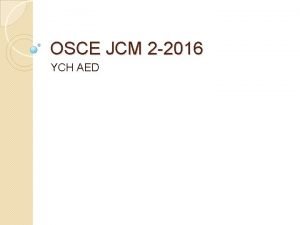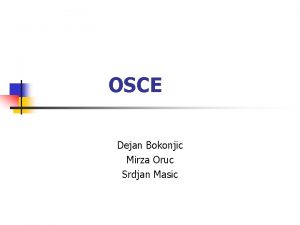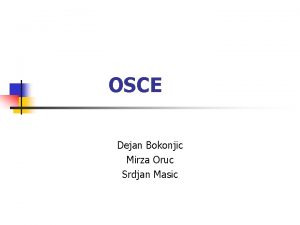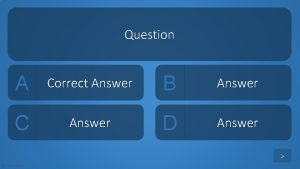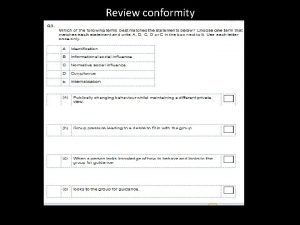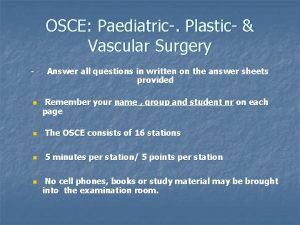OSCE Answer YCH Dr Lo CH 652020 Case

























- Slides: 25

OSCE Answer – YCH Dr Lo CH 6/5/2020

Case 1 • • 14 m / F FTNSD Fever, cough, noisy breathing and SOB on DOA TOCC negative Pulse 140 bpm Sp. O 2 97% (RA) Temp 38. 3 X rays were performed


• 1. What are the x ray findings? –steeple sign –supraglottic distension


• 2. What is the diagnosis? – Croup • 3. How would you assess the severity? – – – by the presence or absence of stridor at rest the degree of chest wall retractions air entry pallor or cyanosis mental status


• 4. What treatment would you give? – Dexamethasone 0. 6 mg /kg po – Nebulized adrenaline 1: 1000 (0. 5 ml/kg, max 5 ml ) – O 2 , antipyretics

• 5. 30 mins after the treatment, the patient improved. Her Mother asked whether the patient can be discharged. How would you advise? – Croup symptoms may recur (after adrenaline effect wear off, usual ~2 hrs ) – Need observation 3 -4 hrs , may discharge if • • No stridor at rest Normal pulse oximetry Good air exchange Normal color Normal level of consciousness Demonstrated ability to tolerate fluids by mouth Caregivers understand the indications for return to care and would be able to return if necessary – FU in next 24 hrs

Case 2. • • • 11/F good past health no urine output and suprapubic distension for 12 hrs. bowel opening P/E: suprapubic mass + Bedside USG was preformed


• 1. What is the USG finding? – distended fluid-filled vagina (Hematocolpos) and uterus (hematometra) • 2. What history would you like to ask? – menstruation history

• 3. What is the diagnosis? – Imperforate hymen • 4. What is the treatment? – Insert foley catheter – Surgical repair

Case 3 • • 63/F Left hand was stung by fish at market (with photo) Sever pain and numbness BP 190/107 P 92

• 1. What is the diagnosis and what initial treatment would you give? – analgesic, hot water immersion (45 C) – X ray, wound exploration for FB – Tetanus prophylaxis

• 2. what specific treatment would you give? – – Stonefish antivenom im -1 vial for 1 -2 punctures -2 vial for 3 -4 punctures -3 vial for >=5 punctures

• 3. what are the complications of the injury? – Necrosis and potential for delayed healing – Infection (e. g. Vibrio)

• Progress of the patient – Given 1 vial of stonefish antivenom im – admitted to EMW – D/C on D 3

Case 4 • 42/F • S/F while chasing bus • Left shoulder injury


• 1. What are the x ray finding and diagnosis? – X ray AP: • humeral head displaced inferomedically to the glenoid fossa • Humerus in marked abduction – Inferior shoulder dislocation (luxatio erecta)

• 2. what are the 2 possible treatment methods in ED? – Traction and counter traction – 2 -step reduction • Convert the inferior dislocation into an anterior dislocation by pushing the proximal humerus anteriorly while pulling the elbow in a superior position • Adduct the arm • Use any reduction technique for anterior dislocation


• 3. What are the complications of the injury? –Brachial plexus nerve injury esp axillary nerve injury –Axillary artery thrombosis –Rotator cuff injury –Fracture of greater tuberosity of humerus, glenoid rim, acromion or clavicle –Glenolabral tear

Thank you
 Paediatric history taking
Paediatric history taking Osce medical
Osce medical Data interpretation osce
Data interpretation osce Osce documentation centre in prague
Osce documentation centre in prague Lanz incision
Lanz incision Osce/ospe
Osce/ospe Osce komprehensif adalah
Osce komprehensif adalah Arbitraje ad hoc
Arbitraje ad hoc Osce
Osce Procedimiento de selección osce
Procedimiento de selección osce Dnacpr osce
Dnacpr osce Respiratory system osce
Respiratory system osce Ranzcp fellowship
Ranzcp fellowship Ice osce
Ice osce Stroke osce
Stroke osce Bad moles on skin
Bad moles on skin Cranial nerve osce
Cranial nerve osce Best case worst case average case
Best case worst case average case Difference between short case and long case
Difference between short case and long case Average case time complexity of binary search
Average case time complexity of binary search Case western reserve university case school of engineering
Case western reserve university case school of engineering Bubble sort algorithm pseudocode
Bubble sort algorithm pseudocode Fbi virtual case file case study
Fbi virtual case file case study Bubble sort best case and worst case
Bubble sort best case and worst case Bubble sort best case and worst case
Bubble sort best case and worst case How to solve the ambiguous case
How to solve the ambiguous case











